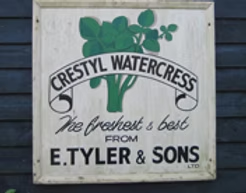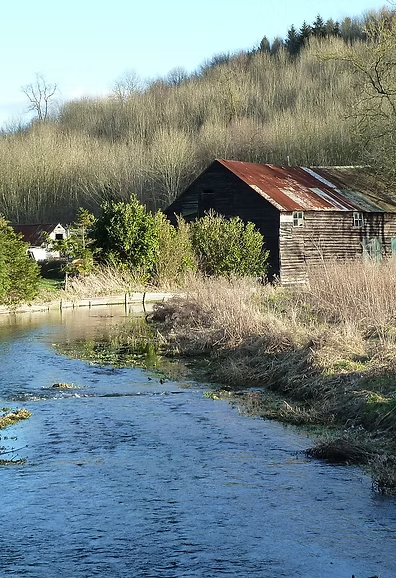
Chenies Watercress – Recollections by Chenies Villager Rose Jane Malling (b 1907)
“During the early part of this Century, up until 1959 Chenies was noted for its watercress. This was grown in spring water in beds along the Chess Valley beside the river itself.
It is essential for the water to be pure and running freely, so the sides of the beds had to be kept clear of weeds and grass and this has made a lot of work during the growing season cutting and pulling out growth. The cress was planted by anchoring bunches with stones. After a time it was ready to be cut and sent to market. The men wore thigh high rubber boots with either thick oiled wool socks or hessian wrapped around their feet and ankles, as the water was very cold and also the feet perspired after a time. It took about an hour to tie up a gross of bunches. As much as one could hold in the hand was tied round with bass (raffia). In the very cold weather there was often ice on the cress and in hot weather it had to have water poured over it to keep it cool.
When it was packed it was stood in the ditch as near as possible to the spring to wait until the time to take it to market. Our cress always went to Covent Garden. Before the last war it was sent by rail from Chalfont Road station on the first train of the day, this meant that my husband had to be up about 4 am to load the cart, catch the horse and get to the station. During the war a van came down to collect it from Sarratt Bottom and Chenies, the driver often sleeping nearby to escape the bombing.
The season for cress is from about March until June depending on the weather, then it runs to flower and seed and beds are cleared, cleaned and reset. When the springs were very low it was sometimes necessary to allow some water to come from the river itself, however when the sewer was built at Chesham this had to stop. Detergents also made it impossible to use the river water and the water from the springs had to be relied upon entirely.
For some reason the watercress got a disease in the roots and despite resetting, buying in some new stock and starting by seed growing it was impossible to get it cleared. This, together with vandals at week-ends, when the cart was pushed into the beds and overturned, dogs in the water churning up the cress and the horse being let out into the road or into the woods made my husband finally decide that he could not carry on and he took on other work.
Some years earlier following a severe thunderstorm and cloudburst the cress was completely washed away and another time when we had a lot of snow the springs were very high and again all the cress was lost.
Local people could buy watercress in very large bunches for sixpence a time. It kept me busy on Saturday mornings when people came to the door for it. Local greengrocers were also served bunches”.
Rose Jane Maling





